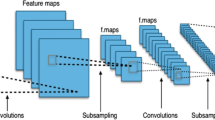Abstract
This paper presents a data-driven approach to classify and locate the faults occurring in underground distribution cables using a CNN-LSTM-based deep learning architecture. A sliding window method is adopted, using the current and voltage signal patches as inputs. The combination of various system parameters is considered to generalize the performance. Additionally, Gaussian noise is added to resemble and extend the approach to practical scenarios. The trained model is evaluated with the data from a new simulation, and the results confirm the generalizability of the adopted method. A comparison is made with other feasible approaches, which show that the adopted method is preferable to achieve better performance. Further, to ease the extension of the proposed method for different systems with similar configurations, parameters of the trained deep learning networks are exploited with the help of transfer learning.










Similar content being viewed by others
References
Livieris IE, Pintelas E, Pintelas P (2020) A CNN–LSTM model for gold price time-series forecasting. Neural Comput Appl. https://doi.org/10.1007/s00521-020-04867-x
Chen K, Hu J, He J (2016) Detection and classification of transmission line faults based on unsupervised feature learning and convolutional sparse autoencoder. IEEE Trans Smart Grid 9(3):1748–1758
Patel B, Bera P (2018) Detection of power swing and fault during power swing using Lissajous figure. IEEE trans power deliv 33(6):3019–3027
Mishra DP, Ray P (2018) Fault detection, location and classification of a transmission line. Neural Comput Appl 30(5):1377–1424
Pandey A, Younan NH (2010) Underground cable fault detection and identification via fourier analysis. In: International conference on high voltage engineering and application. IEEE, pp 618–621
Silva KM, Souza BA, Brito NSD (2006) Fault detection and classification in transmission lines based on wavelet transform and ANN. IEEE trans power deliv 21(4):2058–2063
K. R. K, Dash PK, (2013) A new real-time fast discrete S-transform for cross-differential protection of shunt-compensated power systems. IEEE Trans Power Deliv 28(1):402–410
Jamehbozorg A, Shahrtash SM (2010) A decision-tree-based method for fault classification in single-circuit transmission lines. IEEE Trans Power Deliv 25(4):2190–2196
Mohd Amiruddin AAA, Zabiri H, Taqvi SAA, Tufa LD (2020) Neural network applications in fault diagnosis and detection: an overview of implementations in engineering-related systems. Neural Comput Appl 32(2):447–472
Zimmerman K, Costello D (2005) Impedance-based fault location experience. In: 58th annual conference for protective relay engineers, 2005. IEEE, pp 211–226
Filomena AD, Resener M, Salim RH, Bretas AS (2009) Fault location for underground distribution feeders: an extended impedance-based formulation with capacitive current compensation. Int J Electr Power Energy Syst 31(9):489–496
Provoost F, van Buijtenen W (2009) Practical experience with fault location in MV cable networks. In: IET conference publications. IET, pp 1–4
Sabin DD, Dimitriu C, Santiago D, Baroudi G (2009) Overview of an automatic underground distribution fault location system. In: IEEE power & energy society general meeting. IEEE, pp 1–5
Liang J, Jing T, Niu H, Wang J (2020) Two-terminal fault location method of distribution network based on adaptive convolution neural network. IEEE Access 8:54035–54043
Zhang F, Liu Q, Liu Y, Tong N, Chen S, Zhang C (2020) Novel fault location method for power systems based on attention mechanism and double structure GRU neural network. IEEE Access 8:75237–75248
Mirzaei M, Vahidi B, Hosseinian SH (2019) Accurate fault location and faulted section determination based on deep learning for a parallel-compensated three-terminal transmission line. IET Gener Transm Distrib 13(13):2770–2778
Chi P, Zhang Z, Liang R, Cheng C, Chen S (2020) A CNN recognition method for early stage of 10 kV single core cable based on sheath current. Electric Power Syst Res 184(106292):106292
Lee C-K, Shin Y-J (2021) Detection and assessment of I&C cable faults using time–frequency R-CNN-based reflectometry. IEEE Trans Ind Electron 68:1581–1590
Qiao M, Yan S, Tang X, Xu C (2020) Deep convolutional and LSTM recurrent neural networks for rolling bearing fault diagnosis under strong noises and variable loads. IEEE Access 8:66257–66269
Da Silva FF, Bak CL (2013) Electromagnetic transients in power cables, 2013th edn. Springer, London
Kingma. DP, Jimmy B (2015) Adam: a method for stochastic optimization. In: 3rd international conference for learning representations, pp 1–15
Simonyan K, Zisserman A (2015) Very deep convolutional networks for large-scale image recognition. In: International conference on learning representations, pp 1–15
Koley E, Verma K, Ghosh S (2015) An improved fault detection classification and location scheme based on wavelet transform and artificial neural network for six phase transmission line using single end data only. Springerplus 4:551. https://doi.org/10.1186/s40064-015-1342
Ray P, Mishra DP (2016) Support vector machine based fault classification and location of a long transmission line. Eng Sci Technol Int J 19(3):1368–1380
Terzija VV, Ciric R, Nouri H (2011) Improved fault analysis method based on a new arc resistance formula. IEEE Trans Power Deliv 26(1):120–126
Dargan S, Kumar M, Ayyagari MR, Kumar G (2020) A survey of deep learning and its applications: a new paradigm to machine learning. Arch Comput Methods Eng 27(4):1071–1092
Author information
Authors and Affiliations
Corresponding author
Ethics declarations
Conflict of interest
The authors declared no potential conflicts of interest with respect to the research, authorship and or publication of this article.
Additional information
Publisher's Note
Springer Nature remains neutral with regard to jurisdictional claims in published maps and institutional affiliations.
Rights and permissions
About this article
Cite this article
Swaminathan, R., Mishra, S., Routray, A. et al. A CNN-LSTM-based fault classifier and locator for underground cables. Neural Comput & Applic 33, 15293–15304 (2021). https://doi.org/10.1007/s00521-021-06153-w
Received:
Accepted:
Published:
Issue Date:
DOI: https://doi.org/10.1007/s00521-021-06153-w




